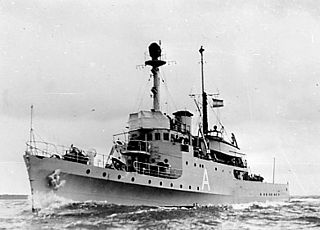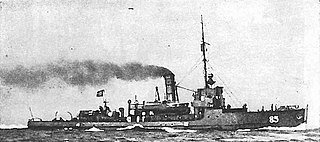Service history
Scuttled at Enkhuizen on 14 May 1940 after the Dutch surrender, the ship was salvaged by the Germans and commissioned into the Kriegsmarine.
In December 1940 she was converted to a torpedo recovery vessel and renamed M 551. In August 1944 the ship was assigned to the 27th U-boat Flotilla, responsible for the tactical training of U-boats.
In 1945 she was returned to the Royal Netherlands Navy, and repaired at the Willemsoord, Den Helder. Recommissioned under her original name in mid-1946, the ship served as fishery inspection vessel. On 16 September 1947 she sailed for the Dutch East Indies where she served as a patrol vessel, and later as a minesweeper with the 1st Flotilla at Surabaya. After her return to the Netherlands in 1950 the ship was converted to boom defence vessel.
Struck in 1961 and transferred to the Zeekadetkorps Nederland (Dutch Sea Cadets) at IJmuiden in 1962, the ship was finally decommissioned in September 1976 and sold for scrap.

The Kortenaer class was a class of anti-submarine frigates of the Royal Netherlands Navy. Like other frigate types of the 1970s and 1980s, they featured a COGOG propulsion system with separate cruise and sprint gas turbines. Ten were built by De Schelde in Vlissingen and two by Wilton-Fijenoord in Schiedam between 1978 and 1982. Only ten served with the Royal Netherlands Navy: two were sold to Greece's Navy while still under construction and replaced by two Jacob van Heemskerck-class frigates which were an air defence variant of the Kortenaer class. The Greek frigates were renamed the Elli class. After service with the Dutch ended, eight of the frigates were sold to Greece in 1992 and the remaining two to the United Arab Emirates. Three of the ships have since been retired from active military service with one converted into the superyacht Yas.

HNLMS Van Speijk was a K-class sloop, designed in the late 1930s to replace the aging Brinio-class gunboats of the Royal Netherlands Navy. Incomplete at the start of the German invasion of the Netherlands and not yet launched, K3 was found undamaged by the German forces. The Kriegsmarine ordered her completion, then commissioned her for service in Norwegian and German home waters.

The German V1-class torpedo boats was a class of 26 large torpedo boats in service with the Imperial German Navy, Reichsmarine, Kriegsmarine and Royal Hellenic Navy in the early 20th century.

Steam gun boats (SGBs) were small Royal Navy vessels built from 1940 to 1942 for Coastal Forces during the Second World War. The class consisted of nine steam-powered torpedo boats.

The R boats were a group of small naval vessels built as minesweepers for the Kriegsmarine before and during the Second World War. They were used for several purposes during the war, and were also used post-war by the German Mine Sweeping Administration for clearing naval mines.

The Jan van Amstel class was a class of nine minesweepers of the Royal Netherlands Navy, built to serve in the Dutch East Indies and Dutch territorial waters in Europe. The class was originally planned to consist of 12 ships, but because of the German occupation of the Netherlands in the Second World War, three of the four ships that were still under construction were never completed.

HNLMS Pieter de Bitter was a Jan van Amstel-class minesweeper of the Royal Netherlands Navy that served in World War II.

HNLMS Eland Dubois was a Jan van Amstel-class minesweeper of the Royal Netherlands Navy that served in World War II.

HNLMS Jan van Amstel was a Jan van Amstel-class minesweeper of the Royal Netherlands Navy that served in World War II.

HNLMS Jan van Gelder was a Jan van Amstel-class minesweeper of the Royal Netherlands Navy that served in World War II.

HNLMS Willem van Ewijck was a Jan van Amstel-class minesweeper of the Royal Netherlands Navy.

HNLMS Abraham van der Hulst was a Jan van Amstel-class minesweeper built for the Royal Netherlands Navy in the 1930s. The German invasion of the Netherlands resulted in the ship being scuttled at Enkhuizen on 14 May 1940, but was raised by the Germans and entered service as the minesweeper M 553 with Nazi Germany's Kriegsmarine. The vessel was sunk by a mine off East Prussia on 21 April 1944. M 552 was raised on 20 July 1944 and towed to Stettin. There, the ship was bombed and burned out 20 August 1944. The wreck was captured by the Soviets. One source says she was returned to the Netherlands post war.

HNLMS Abraham van der Hulst was a Jan van Amstel-class minesweeper of the Royal Netherlands Navy.

The Douwe Aukes class were two minelayers of the Royal Netherlands Navy. The two ships were built at the Gusto shipyard in Schiedam. Construction began in 1919 and was completed in 1922. Built to serve in the Dutch territorial waters, both ships were still in service during the Second World War and they both escaped to the United Kingdom, HNLMS Douwe Aukes on 14 May and HNLMS Van Meerlant on 18 May 1940. Both vessels were transferred to the British Royal Navy. Van Meerlant was sunk by a mine in 1942 while in British service. Douwe Aukes was returned to the Royal Netherlands Navy following the war and was used as a depot ship until sold for scrap in 1962.

ZH1 was the lead ship of her class of four destroyers built for the Royal Netherlands Navy in the late 1930s. Originally named Gerard Callenburgh, the ship was scuttled while still incomplete by the Dutch during the German invasion of the Netherlands in May 1940, but she was salvaged by the Germans a few months later and commissioned in the Kriegsmarine in 1942 as ZH1.

Yamakaze was an Umikaze-class destroyer of the Imperial Japanese Navy. The second and last ship of this class to be built, she was completed in 1911. After mostly serving as a coastal patrol boat during World War I, she was converted to a minesweeper on June 1, 1930, along with her sister ship, Umikaze. On April 1, 1936 she was scrapped after 25 years of service.

The German torpedo boat T3 was one of a dozen Type 35 torpedo boats built for the Kriegsmarine during the late 1930s. Completed during the Second World War in 1940, she was assigned to escort duties between Germany and Occupied Norway in August before beginning to escort minelayers in the North Sea the following month. The boat was sunk in France by British bombers in September and was refloated the following year. T3 was assigned to the Torpedo School when her repairs were completed in 1943. She returned to active duty a year later and escorted German ships as they bombarded Soviet positions. The boat sank a Soviet submarine in early 1944 and she struck a mine in March 1945 and sank with heavy loss of life.

The Type 1940 torpedo boats were a group of 24 torpedo boats that were intended to be built for Germany's Kriegsmarine during World War II. Although classed as fleet torpedo boats by the Germans, they were comparable to contemporary large destroyers. They were designed around surplus Dutch propulsion machinery available after the Germans conquered the Netherlands in May 1940 and were to be built in Dutch shipyards. Hampered by uncooperative Dutch workers and material shortages, none of the ships were completed before the Allies invaded Normandy in June 1944. The Germans towed the three ships that were most complete to Germany to be finished, but one was sunk en route by Allied fighter-bombers and no further work was done of the pair that did arrive successfully. The remaining ships in the Netherlands were later broken up for scrap and the two that reached Germany were scuttled in 1946.

SMS M85 was a M1916 type minesweeper built for the Imperial German Navy during the First World War by the Emden shipyard Nordseewerke, being launched on 10 April 1918 and entering service on 2 October that year. M85 survived the remainder of the war, and was passed on to the Reichsmarine, the navy of the Weimar Republic and then to the Nazi German Kriegsmarine. The outbreak of the Second World War saw M85 supporting the German invasion of Poland in September 1939, and she was sunk by a Polish mine on 1 October 1939 in one of the last acts of the Polish campaign.

The Haarlemmermeer class was a class of nine gunvessels of the Royal Netherlands Navy. The class was a failure because of its extreme susceptibility to dry rot.
This page is based on this
Wikipedia article Text is available under the
CC BY-SA 4.0 license; additional terms may apply.
Images, videos and audio are available under their respective licenses.


















